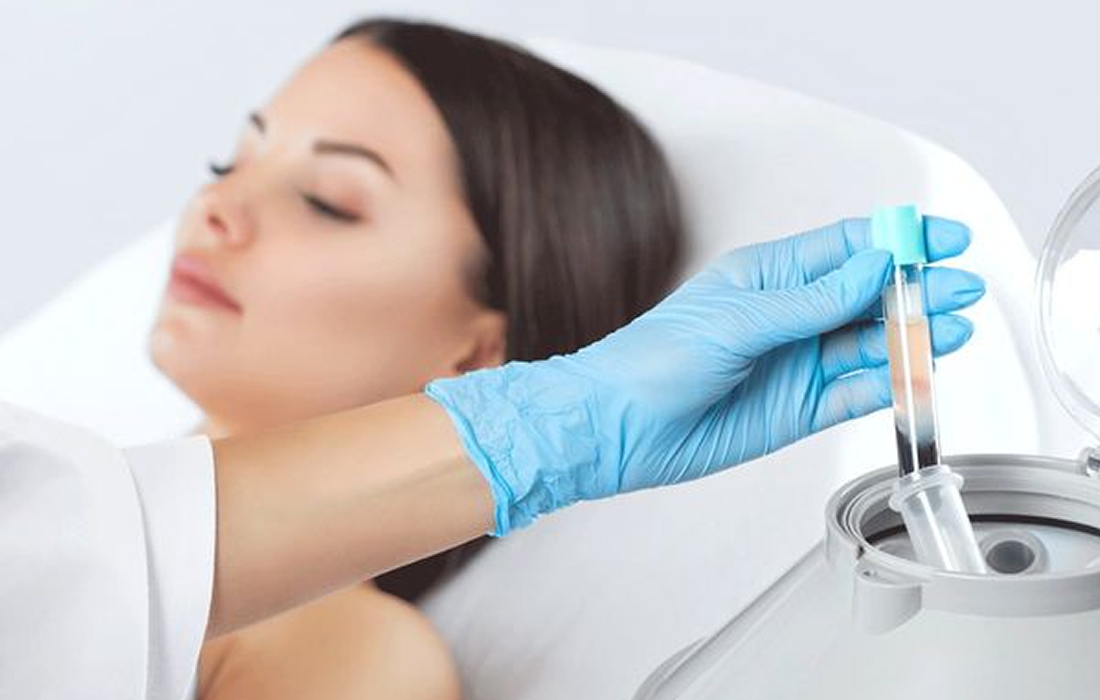Platelet-Rich Plasma
Platelet-Rich Plasma for Skin Rejuvenation
Platelet-rich plasma (PRP) is autologous blood plasma with a concentration of platelets well above baseline. The usual concentration of platelets in the blood is approximately 150,000 to 400,000 platelets per cubic microliter. PRP contains 4-7 times the physiologic concentration of platelets.
PRP is prepared by centrifugation of blood drawn from the patient before any procedure or surgery. Some of the growth factors that PRP contains are:
- Platelet-derived growth factor: can initiate connective tissue healing, increases mitogenesis and angiogenesis and enhances collagen synthesis.
- Transforming growth factor-β: increases chemotaxis and stimulates deposition of collagen matrix.
- Fibroblast growth factor: stimulates angiogenesis, proliferation of myoblasts and promotes migration of fibroblasts.
- Epidermal growth factor: increases proliferation of mesenchymal cells, epithelial cells and stimulates differentiation of epithelial cells.
- Keratinocyte growth factor: stimulates epithelization.
- Vascular endothelial growth factor: increases vascular permeability, enhances endothelial cell migration and proliferation.
Application of PRP for Skin rejuvenation
Use in conjunction with microneedling
Microneedling is the result of multiple, often oscillating needles causing damage to the skin, which then induces the skin itself to repair by collagen stimulation. They reach the papillary and reticular dermis in a purely mechanical way. Therefore, there is preservation of stratum corneum and the epidermal barrier function, leading to the lack of scarring.
This trauma alone can activate the healing process. Immediately following the injury, fibroblasts inundate the region for wound healing, stimulating endothelial cells and starting the process of angiogenesis, as well as elastin and collagen production. Commonly termed collagen induction therapy, microneedling has been used to improve the appearance of acne scarring, skin discoloration, melasma, fine lines, wrinkles and facial scars. When used in conjunction with PRP, its effects can be potentiated and can help improve skin elasticity.
Use as facial injection
PRP is commonly injected to the face and neck to help increase facial volume through collagen stimulation. This injection can be either intradermal or subdermal, or a combination of the two. PRP injections have been shown to improve the skin color and texture as well as the depth of fine lines and wrinkles through an increase of dermal collagen.
In general, these treatments are done at 4- to 6-week intervals and repeated at least 3-5 times, or until the desired result is achieved. Additional procedures for maintenance are performed in a timeline that is spaced out for maintenance.
Microneedling with PRP and injections of PRP can be combined during the same treatment. For most patients, microneedling will help the overall skin texture, whereas injections will further help collagen stimulation from the deeper tissues, helping to improve volume.
Patients should always avoid direct sunlight immediately after and for at least 2 weeks following the procedure. Sun protection should always be used. Hydration of the skin is also important and can be achieved with a variety of hyaluronic acid serums.
PRP is increasingly being utilized for hair loss, scarring and facial rejuvenation. Currently, PRP appears to be safe with no long-term side effects noted. It may be used synergistically with existing treatment options with added benefit.
Source:
Peng, G. L. (2019). Platelet-Rich Plasma for Skin Rejuvenation. Facial Plastic Surgery Clinics of North America, 27(3), 405–411.

